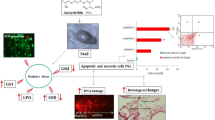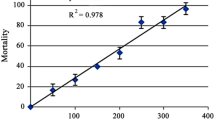Abstract
Extensive production and use of organophosphate pesticide in agriculture, has risen concerned about its ecotoxicity and risk assessment of insecticides, which are more important. Therefore, the present investigation was aimed to study the induction of oxidative stress and DNA damage by organophosphate insecticide profenofos (PFF) in freshwater snail Lymnea luteola (L. luteola). The median lethal value (96 h LC50) of PFF was estimated as 1.26 mg/L for L. luteola in a semi-static system and on the basis of LC50 value three concentrations viz., 0.126 (1/10 of LC50, Sublethal I), 0.63 (1/2 of LC50, Sublethal II) and 0.84 mg/L (2/3 of LC50, Sublethal III) were determined. Snails were exposed to above-mentioned concentrations of PFF along with solvent control (acetone) and negative control for 96 h. The haemolymph was collected at 24 and 96 h of after treatment. In heamolymph of PFF exposed snail, lipid peroxide, glutathione reduced glutathione S transferase and superoxide dismutase activities at the tested concentrations significantly differ from those in the control. The genotoxicity induced in hemocytes of treated snails was measured by alkaline single cell gel electrophoresis assay. The data of this experiment demonstrated significantly enhancement of oxidative stress and DNA damage in the treated snails as compared to controls. Also, we observed statistically significant correlations of ROS with DNA damage (% tail DNA) (R2 = 0.9708) for 24 h and DNA damage (R2 = 0.9665) for 96 h.
Results of the current experiment can be useful in risk evaluation of PFF among aquatic organisms. The study confirmed the use of comet assay for in vivo laboratory experiments using freshwater snail for selecting the toxic potential of industrial chemicals and environmental contaminants.

Similar content being viewed by others
References
Akcha F, Vincent Hubert F, Pfhol-Leszkowicz A (2003). Potential value of the comet assay and DNA adduct measurement in dab (Limanda limanda) for assessment of in situ exposure to genotoxic compounds. Mutat Res, 534(1-2): 21–32
Ali D, Ahmed M, Alarifi S, Ali H (2015). Ecotoxicity of single-wall carbon nanotubes to freshwater snail Lymnaea luteola L.: Impacts on oxidative stress and genotoxicity. Environmental Toxicology, 30(6): 674–682
Ali D, Nagpure N S, Kumar S, Kumar R, Kushwaha B, Lakra W S (2009). Assessment of genotoxic and mutagenic effects of chlorpyrifos in freshwater fish Channa punctatus (Bloch) using micronucleus assay and alkaline single-cell gel electrophoresis. Food and Chemical Toxicology, 47(3): 650–656
Anderson D, Yu T W, Phillips B J, Schmezer P (1994). The effect of various antioxidants and other modifying agents on oxygen-radicalgenerated DNA damage in human lymphocytes in the COMET assay. Mutation Research, 307(1): 261–271
APHA AWWA, WPCF (1998). Standard methods for examination of water and wastewater, 20th ed. American Public Health Association, New York
Arabi M, Alaeddini M A (2005). Metal ion mediated oxidative stress in the gill homogenate of rainbow trout (Onchorhynchus mykiss). Biological Trace Element Research, 108: 155–168
Becker J S, Füllner K, Seeling U D, Fornalczyk G, Kuhn A J (2008). Measuring magnesium, calcium and potassium isotope ratios using ICP-QMS with an octopole collision cell in tracer studies of nutrient uptake and translocation in plants. Analytical Bioanalytical Chemistry, 390(2): 571–578
Demir F, Uzun F G, Durakn D, Kalender Y (2011). Subacute chlorpyrifos induced oxidative stress in rat erythrocytes and the protective effects of catechin and quercetin. Pesticide Biochemical Physiology, 99(1): 79–81
Finney D J (1971). Probit Analysis. Cambridge: Cambridge University Press, 333 p
Köhler H R, Triebskorn R (2013). Wildlife ecotoxicology of pesticides: Can we track effects to the population level and beyond? Science, 341(6147): 759–765
Kohn K W (1991). Principles and practice of DNA filter elution. Pharmacology & Therapeutics, 49(1-2): 55–77
Kumaravel T S, Jha A N (2006). Reliable Comet assay measurements for detecting DNA damage induced by ionising radiation and chemicals. Mutation Research, 605(1-2): 7–16
Lever J, Bekius R (1965). On the presence of an external hemal pore in Lymnaea stagnalis L. Experientia, 21(7): 395–396
Liu Y, Wang J, Wei Y, Zhang H, Xu M, Dai J (2008). Induction of timedependent oxidative stress and related transcriptional effects of perfluorododecanoic acid in zebrafish liver. Aquatic Toxicology, 89 (4): 242–250
Lushchak V I (2011). Environmentally induced oxidative stress in aquatic animals. Aquatic Toxicology, 101(1): 13–30
Malla T M, Senthikumar C S, Akhtar S, Ganesh N (2011). Micronuclei as an evidence of DNA damage in fresh water catfish Heteroneustes fossilis (Blotch) exposed to synthetic sindoor, ARPN Journal of Agricultural and Biological Science, 95: 351–358
Miller G T (2004). Chapter 9, Sustaining the Earth, 6th ed. Pacific Grove, California: Thompson Learning, Inc., 211–216
Monteiro D A, de Almeida J A, Rantin F T, Kalinin A L (2006). Oxidative stress biomarkers in the freshwater characid fish, Brycon cephalus, exposed to organophosphorus insecticide Folisuper 600 (methyl parathion). Comparative Biochemistry and Physiology—Part C, 143(2): 141–149
Ohkawa H, Ohishi N, Yagi K (1979). Assay for lipid peroxides in animal tissues by thiobarbituric acid reaction. Anal Biochem, 95(2): 351–358
Palmer W E, Bromley P T, Brandenburg R L (2007). Wildlife and pesticides-peanuts. North Carolina Cooperative Extension Service
Pamanji R, Yashwanth B, Bethu MS, Leelavathi S, Ravinder K, Rao J V (2015). Toxicity effects of profenofos on embryonic and larval development of Zebrafish (Danio rerio). Environmental Toxicology Pharmacol, 39(2): 887–897
Rank J, Jensen K, Jespersen PH (2005). Monitoring DNA damage in indigenous blue mussels (Mytilus edulis) sampled from coastal sites in Denmark Mutation Research, 585: 33–42
Rowe L A, Degtyareva N, Doetsch P W (2008). DNA damage-induced reactive oxygen species (ROS) stress response in Saccharomyces cerevisiae. Free Radical Biology and Medicine, 45(8): 1167–1177
Subudhi A W, Davis S L, Kipp R W, Askew E W (2001). Antioxidant status and oxidative stress in elite alpine ski racers. International Journal of Sport Nutrition and Exercise Metabolism, 11(1): 32–41
Valencia A, Kochevar I E (2006). Ultraviolet A induces apoptosis via reactive oxygen species in a model for Smith-Lemli-Opitz syndrome. Free Radical Biology and Medicine, 40(4): 641–650
Yassi A, Kjellstrom T (1997). Linkages between environmental and occupational health. Chapter 53 environmental health hazards PartVII-The environment. Encyclopaedia of occupational health and safety, 4th ed. www.ilocis.org/documents/chpt53e.htm
Acknowledgements
The authors are grateful to the Deanship of Scientific Research at King Saud University for funding this research (RG-1435-076).
Author information
Authors and Affiliations
Corresponding author
Rights and permissions
About this article
Cite this article
Ali, D., Ali, H., Alifiri, S. et al. Detection of oxidative stress and DNA damage in freshwater snail Lymnea leuteola exposed to profenofos. Front. Environ. Sci. Eng. 12, 1 (2018). https://doi.org/10.1007/s11783-018-1039-6
Received:
Revised:
Accepted:
Published:
DOI: https://doi.org/10.1007/s11783-018-1039-6




